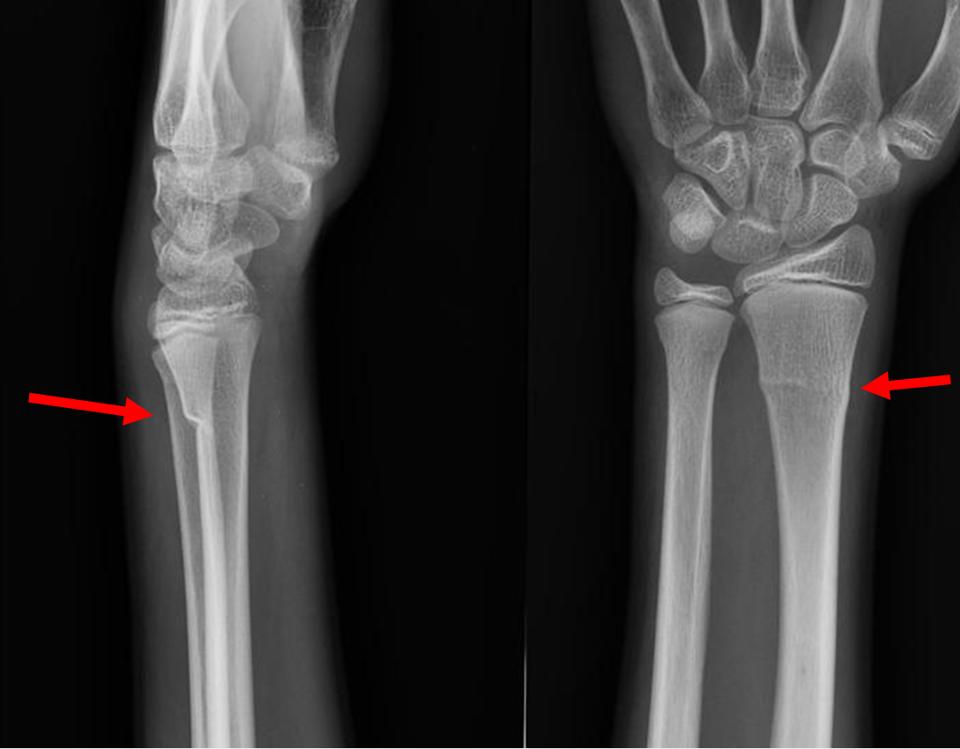Introduction
Your child has suffered a "Torus/Buckle" fracture to the wrist bone (Figure 1).

A fracture and a break are the same things. Young bone is still soft and very flexible. For this reason, instead of breaking through, the bone only has a small crack or kink on one side. This is a common injury for walking children following a fall onto the hand.
What are the symptoms?
Your child may experience some or all of the following symptoms:
- Pain in the wrist
- Reluctant to use the hand, such as gripping objects or turning the door handle
- Swelling
How is it diagnosed?
After an assessment, the treating Doctor/Nurse practitioner will request an x-ray to confirm the child has this injury.
Treatment
- This type of injury heals very well using a removable Velcro splint compared to a cumbersome plaster cast.
- The splint helps relieve the pain and discomfort.
- Most of these types of injuries heal perfectly, if the splint is worn for three weeks.
- The splint can be removed for bathing/showering/toileting without causing more damage. The health professional will advise how to remove/reapply the splint.
- If your child removes the splint before three weeks, is comfortable and can use the wrist freely, there is NO reason to force them to wear the splint for the remaining three weeks.
Pain relief and comfort
This type of injury is stable and heals quickly without problems; therefore, no further follow-up (x-ray, physiotherapy, GP, orthopaedic clinic) is required.
For the first week, give your child appropriate doses of regular simple painkillers such as Paracetamol and/or Ibuprofen (if allergic/intolerant, inform the treating health professional). These medicines can be purchased over the counter or obtained from a high street pharmacy using the Minor Ailments Service.
After three weeks
- Provide the child with painkillers 30 to 40 minutes before removing the splint.
- Observe the child trying to use the wrist.
- If it is still sore or stiff, reapply the splint for comfort. Do this for short periods (1 to 2 hours), as it is best to start gently using the wrist from now on.
- If the wrist is very sore and or swollen after three weeks or your child refuses to use the wrist, please contact your GP during working hours.
Getting back to normal
Your child can return to school and may return to sports such as swimming as soon as comfortable, but should avoid contact sports for six weeks e.g. football, rugby, netball, basketball..
If your child removes the splint before three weeks, appears to be comfortable, and uses the arm freely, then there is NO reason to force them to wear the splint for the full three weeks.
Worries or concerns
If the wrist still looks pretty sore or swollen after three weeks or your child is not willing to use it, please contact the virtual fracture clinic on 01592 643355 extension 20140 and leave a message. A member of the VFC team will contact you. For urgent problems call 01592 643355 Extension 22685 or concerns out with working hours, please get in touch with NHS 24 on 111.
Accessible formats
If you require this information in a community language or alternative format such as Braille, audio, large print, BSL, or Easy Read, please contact the Equality and Human Rights Team at: email: fife.EqualityandHumanRights@nhs.scot or phone 01592 729130. For people with a hearing or verbal impairment you can also contact the team through the NHS Fife SMS text service number on 07805800005.




